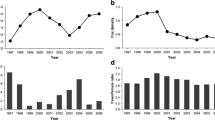Summary
During a severe outbreak of sarcoptic mange (Sarcoptes scabiei vulpes) starting among red foxes (Vulpes vulpes) in Sweden in the 1970s, we studied: 1) the establishment and spread of the disease in northernmost Sweden (by inquiries), and 2) the 1970–84 bag records for foxes and mountain hares (Lepus timidus) (an alternative prey to the fox's main prey, voles). Since the first case of sarcoptic mange in 1975 the disease spread rapidly, with >50% of the hunting organizations having reported the disease in 1981 and >75% in 1983. Also the disease became more abundant within the areas affected. In areas with a low mange infection rate (index) the number of foxes killed in the 1980s did not deviate markedly from the average level in the 1970s. However, there was a slight tendency towards a decline in areas with a medium index and numbers declined markedly where the index was high. Hare harvests initially were low (after a tularemia epidemic) in the 1970s. In that decade harvests increased dramatically and stabilized, increased gradually or changed little, respectively, where mange infection rates were low, medium or high in the early 1980s. In areas with a low mange index hare harvests remained cyclical and at the same level in the 1980s as in most of the 1970s. However, in areas with a medium index harvests increased and seemed to begin to lose their cyclicity, and where the index was high the low and relatively stable hare harvests increased annually. A predator-prey hypothesis, assuming predators to synchronize alternative prey declines to those of the cyclic main prey, predicts that a predator reduction would cause a gradual disappearance of the cyclicity and increasing numbers among alternative prey. Our hare data are partially consistent with this prediction.
Similar content being viewed by others
References
Angelstam P, Lindström E, Widén P (1984) Role of predation in short-term population fluctuations of some birds and mammals in Fennoscandia. Oecologia (Berlin) 62:199–208
Angelstam P, Lindström E, Widén P (1985) Synchronous short-term population fluctuations of some birds and mammals in Fennoscandia — occurrence and distribution. Holarct Ecol 8:285–298
Borg K, Hanko E, Krunajevic T, Nilsson N-G, Nilsson PO (1969) On tularemia in the varying hare (Lepus timidus L.). Nord Vet Med 21:95–104
Borg K, Christensson D, Fabiansson E, Kronevi T, Nilsson PO, Uggla A (1976) Rävskabb i Sverige. Svensk Jakt 114:504–506 (In Swedish)
Christensson D (1972) Sarcoptes-skabb hos vild rödräv. Svensk Veterinärtidning 24:470–471 (In Swedish)
Danell K (1978) Population dynamics of the muskrat in a shallow Swedish lake. J Anim Ecol 47:697–709
Danell K (1985) Population fluctuations of the muskrat in coastal northern Sweden. Acta Theriol 30:219–227
Englund J (1965) Studies on food ecology of the red fox (Vulpes v.) in Sweden. Viltrevy 3:377–485
M'Fadyean J (1898) Sarcoptic mange in foxes. J Comp Pathol 11:92–93
Gerasimoff YA (1958) Mange in wild foxes. Translations of Russian Game Reports. vol 3: Arctic and red foxes 1951–55. The Queen's Printer, Ottawa, p 214
Hagen Y (1952) Rovfuglene og viltpleien. Gyldendal Norsk Forlag, Oslo (In Norwegian)
Hansson L (1979) Food as a limiting factor for small rodent numbers — tests of two hypotheses. Oecologia (Berlin) 37:297–314
Henriksson K (1971) Sarcoptic mange in wild red fox in Finland. Suomen Riista 23:127–135 (In Finnish with English summary)
Holt G (1976) Skabb hos rev. Norsk Veterinaertidskrift 88:116–117 (In Norwegian)
Hörnfeldt B (1978) Synchronous population fluctuations in voles, small game, owls, and tularemia in Northern Sweden. Oecologia (Berlin) 32:141–152
Hörnfeldt B, Löfgren O, Carlsson B-G (1986) Cycles in voles and small game in relation to variations in plant production indices in Northern Sweden. Oecologia (Berlin) 68:496–502
Keith LB (1974) Some features of population dynamics in mammals. Int Congr Game Biol 11:17–58
Keith LB (1983) Role of food in hare population cycles. Oikos 40:385–395
Lack D (1954) The natural regulation of animal numbers. Clarendon Press, Oxford, p 343
Lindström E (1982) Population ecology of the red fox (Vulpes vulpes L.) in relation to food supply. PhD thesis, University of Stockholm, Sweden
Lindström E, Mörner T (1985) The spreading of sarcoptic mange among Swedish red foxes (Vulpes vulpes L.) in relation to fox population dynamics. Rev d'Ecologie, Terre et Vie 40:211–216
Myllymäki A, Christiansen E, Hansson L (1977) Five year surveillance of small mammal abundance in Scandinavia. EPPO Bull 7:385–396
Mörner T (1984) The epizootic outbreak of sarcoptic mange in Swedish red foxes (Vulpes vulpes). Proc IV Int Congr Wildl Dis, pp 124–130
Mörner T, Christensson D (1984) Experimental infection of red foxes (Vulpes vulpes) with Sarcoptes scabiei var. vulpes. Vet Parasitol 15:159–164
Olive JR, Riley CV (1948) Sarcoptic mange in the red fox in Ohio. J Mammal 29:73–74
Plummer PJG (1936) Skin scabies or mange of the fox. Can Dep Agric Publ 502, Farmer's Bull 6. p 8
Schoop G (1941) Über die Fuchsräude. Deutsche Tierärztl Wochenschr 49:485–486
Trainer DO, Hale JB (1969) Sarcoptic mange in red foxes and coyotes of Wisconsin. Bull Wildl Dis Assoc 5:387–391
Author information
Authors and Affiliations
Rights and permissions
About this article
Cite this article
Danell, K., Hörnfeldt, B. Numerical responses by populations of red fox and mountain hare during an outbreak of sarcoptic mange. Oecologia 73, 533–536 (1987). https://doi.org/10.1007/BF00379412
Received:
Issue Date:
DOI: https://doi.org/10.1007/BF00379412




